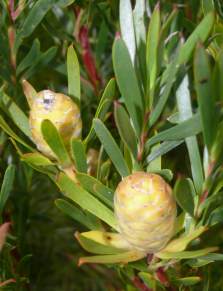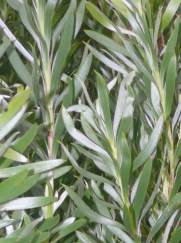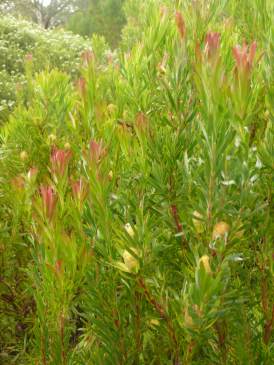Leucadendron xanthoconus
Leucadendron xanthoconus (Kuntze) K.Schum.
Family: Proteaceae
Common names: sickle-leaf conebush ( Eng. ); blinkblaartolbos (Afr.)
Introduction
A versatile fynbos shrub, with a silvery shine to its foliage, Leucadendron xanthoconus deserves a second glance.

Description
Description

Leucadendron xanthoconus is a single-stemmed, dense, perennial shrub which can reach up to 2 m tall; it grows fairly quickly. The leaves are slightly sickle-shaped and are covered in silvery hairs when immature. The male and female inflorescences occur on separate plants. The bracts around the inflorescence are yellow. Flowering occurs in August. Fruits are seen as cones which house the winged seeds. Seeds are retained on the bush to be released after fire.
Conservation Status
Status
Not threatened and occurs in dense stands.
Distribution and habitat
Distribution description
The blinkblaartolbos occurs on lower slopes in well-drained sandstone soils. It is found at altitudes varying from up to 670 m in the winter rainfall area of the Western Cape, from the Cape Peninsula to Potberg; including the Hottentots-Holland, Groenland, Kogelberg, Kleinmond, Klein River and Bredasdorp Mountains, the Elim Flats, Caledon Swartberg and Riviersonderend Mountains.
Derivation of name and historical aspects
History
The Proteaceae is one of the most prominent flowering plant families. There are about 1 400 species in more than 60 genera, which occur in southern hemisphere countries. Australia has 45 genera and Africa has 14 genera, of which more than 330 species occur in the southwestern Cape alone. Other countries where they occur include Central and South America, islands east of New Guinea, New Caledonia, Madagascar, southeast Asia, New Guinea and New Zealand.
The family is an ancient one and existed in the time of the dinosaurs. The Proteaceae vary from groundcovers to trees, with genera such as Protea, Leucadendron, Leucospermum, Serruria and Paranomus to name a few. This may be the reason behind its original naming by Carl Linnaeus, the father or taxonomy. Proteus was the mythological Greek god who could see the future and always spoke the truth, but in order to extract a prophecy, one had to grasp him tightly while he changed into numerous animate or inanimate forms.
Leucadendron, pronounced loo-ka-den-dron, gains its origins from the Greek word Leucos meaning white and dendron meaning a tree, referring to the silver tree, Leucadendron argenteum.
Ecology
Ecology
The sickle-leaf conebush is pollinated by small beetles. Cones on the female plant retain the seed and only release them after fire. This reduces the loss of viable seed to predation. Seeds are winged and dispersed by wind. The parent plant will not survive a fire, but will be replaced by seedlings.
Germination of seeds is stimulated by warm days followed by cool nights as occur in autumn. These temperatures presage the winter rains that will help sustain a growing young seedling.
Uses
Use
Currently, Leucadendron xanthoconus is not used enough in horticultural plantings, but has great value as a filler and backdrop foliage plant in the fynbos garden scene.

Growing Leucadendron xanthoconus
Grow
Propagation can be done via cuttings or seed, seed being the easiest.
Sow seed in June. Seed requires warm day and cold night temperatures to germinate. Prepare seed trays containing a well-drained mix of bark and fynbos soil (50:50). Scatter seed on top and lightly cover with river sand. Water in well and use a fungicide treatment. Keep seed tray moist, not wet. Seed germination varies and will sometimes even only germinate the following year. As the first true leaves appear, transplant the seedlings into pots in a well-drained, sandy fynbos mix. Grow on for a year before transplanting into the garden.
Take tip cuttings from December to March. Use a rooting hormone and place in a well-drained mix of bark and polyurethane. Cuttings must be kept humid, but not wet. Rooting occurs in approximately five weeks. Harden off rooted cuttings for three weeks and then transplant into pots as for seedlings.
In the garden L. xanthoconus can be used as a filler shrub or a background stand. With its average height it makes a good mid-layer planting. Used in conjunction with other fynbos species such as Restio, buchu and Erica, it makes a lovely display. It can be used in rockeries and open bed plantings. A root pathogen, Phytophtera, is detrimental to the Proteaceae. Symptoms include the plant looking wilted and dry followed by yellowing and death. As these symptoms are only seen once the fungus has damaged the plant, the best course of action is to remove the infected plant and burn it; thereafter, sterilize the affected soil with a contact fungicide and refrain from replanting Proteaceae in that area. Good general plant hygiene and healthy vigorous mother stock will increase the potential of younger plants to remain healthy.
Regular pruning will encourage dense foliage and keep plant to specific height. Prune the branches back to healthy green leaves, never to a bare stem.
References
- Coombes, A.J. 1992. Guide to plant names. Reed International Books, London.
- Germishuizen, G. & Meyer, N.L. (eds). 2003. Plants of southern Africa : an annotated checklist. Strelitzia 14. National Botanical Institute, Pretoria.
- Leistner, O.A. (ed.). 2000. Seeds plants of southern Africa : families and genera. Strelitzia 10. National Botanical Institute, Pretoria.
- Rebelo, A.G. 1995. A field guide to the proteas of southern Africa, edn 2. Fernwood Press, Vlaeberg.
- Rousseau, F. 1970. The Proteaceae of southern Africa. Purnell, Cape Town.
- Smith, C.A. 1966. Common names of South African plants. Memoirs of the Botanical Survey of South Africa No. 35.
- Stearn, W.T. 1966. Botanical Latin, edn 4. Timber Press, USA.
- Stearn, W.T. 1992. Stearn's dictionary of plant names for gardeners. Timbr Press, USA.
- Williams, I.O. 1969. Leucadendron tinctum. The Flowering Plants of Africa 39: t. 1527.
Credits
Monique Twine
Kirstenbosch National Botanical Gardens
July 2007
Plant Attributes:
Plant Type: Shrub
SA Distribution: Western Cape
Soil type: Sandy, Loam
Flowering season: Winter
PH: Acid
Flower colour: Yellow
Aspect: Full Sun
Gardening skill: Average
Special Features:
Horticultural zones








Rate this article
Article well written and informative
Rate this plant
Is this an interesting plant?
Login to add your Comment
Back to topNot registered yet? Click here to register.